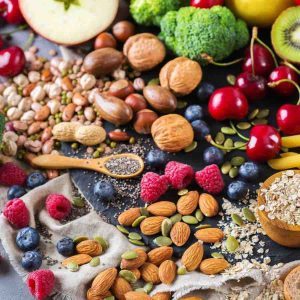
Learn about fiber, its impact on short and long-term health, and easy ways to eat more of it in your diet.
Have you ever wondered about the benefits of fiber for your family? Fiber is found in all plant-based foods – fruits, vegetables, whole grains, nuts, seeds, and legumes. Understanding the critical role fiber plays in health will make it easier to prioritize this vital nutrient in your family’s meals and snacks. If you’re looking for specific high fiber foods and ways to eat them, take a look at How Much Fiber Per Day Do Kids Needs?
What is fiber?
Fiber is a type of carbohydrate found in plants that our digestive tract doesn’t break down or absorb like other carbohydrates. It might sound like fiber doesn’t play a huge role in our family’s health, but it actually does.
There are two different types of fiber, soluble and insoluble. Both types are found in a variety of different plant foods, and each has its unique health benefits.
What is the difference between soluble and insoluble fiber?
Soluble fiber
Soluble fiber dissolves in water and forms a gel-like substance that can help slow digestion. (1) Soluble fiber is found in foods like oatmeal, nuts, beans, lentils, seeds, and some fruits and vegetables, like apples, blueberries, and brussels sprouts. (2)
Insoluble fiber
Insoluble fiber cannot dissolve in water. Instead, it helps to create bulk in our stools and promotes regularity in our digestive system. (2) Insoluble fiber is found in foods like wheat, whole-wheat bread, whole-grain products, brown rice, legumes, and vegetables like carrots, cucumbers, and tomatoes. (2)
Benefits of Soluble Fiber
Soluble fiber can help to lower total cholesterol as well as LDL-cholesterol. Our bodies absorb less cholesterol and fat when we eat soluble fiber. (1)Because soluble fiber forms a gel-like substance when moving through the digestive tract, it causes digestion to slow down. This means that the sugar from our food is being absorbed more slowly, which can help regulate blood sugar, lowering our risk of insulin resistance and type 2 diabetes. (3) Type 2 diabetes can start in kids, so making small changes in your family’s diet can have long-lasting effects. Boosting foods high in fiber today sets them up for better eating habits later.
Insoluble Fiber Benefits
Because insoluble fiber creates bulk in our stools, it helps food move more easily through our digestive tract. (2) This keeps our bowels regular and comfortable! Check out our free guide, The Scoop on Poop, for more insights into your child’s stools and patterns.
More Fiber Benefits
In addition to the specific benefits above, fiber can help:
- lower inflammation which can contribute to chronic disease
- slow digestion which may help control and better manage appetite
- play a role in healthy weight management
- reduce the risk for certain types of cancers, heart disease, and obesity
- increase and improve healthy gut bacteria
Foods high in fiber are often high in phytochemicals, antioxidants, vitamins, and minerals, and low in fat, cholesterol, and calories.
Easy Ways to Eat More Fiber
There are endless ways to effortlessly get a few more grams of fiber into each meal. Here are a few places to start:
- Add a serving of beans to your daily diet. Try lentil soup, bean dips, and chilis’.
- Make plant-based whole foods part your go-to snacks, like roasted or fresh bell pepper slices, apple donuts, or jicama.
- Choose whole grains over refined. Choose whole oats and add in your own fruit, nuts, and honey. Try buckwheat soba noodles, polenta rounds, or whole-grain fruit bars. Swap white bread for a whole-wheat or whole-grain bread. Check the ingredient list and make sure “whole-wheat flour” is the first ingredient.
- Get your kids to eat their fruit instead of drinking it! Offer an orange or apple with breakfast instead of a glass of OJ or apple juice.
- Don’t peel fruits and veggies! Leave the skin on apples, cucumbers, and potatoes for an extra fiber boost.
Use these helpful resources to make sure your kids aren’t missing out on fiber!
- To boost meals and snacks with fiber, shop SuperKids Nutrition Founder’s books – The Plant-Based Boost Cookbook with Over 100 + Recipes or The Super Crew’s Breakfast Cookbook, with 50 Recipes and 100+ Fun Nutrition Activities,
- How much fiber do my children need?
- 6 more ways to boost fiber
- How to prevent constipation in kids












